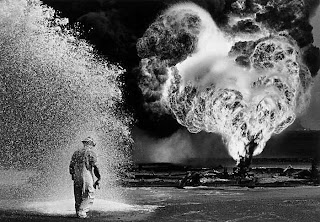In the 19th century, technological and chemical advances made it possible to take camera equipment out to the great wildernesses, and demand for images of the unseen world made it viable to capture the 'new world' and all its wonders. Coinciding with this was the transport revolution which made it possible for people to travel further afield and perhaps start a new life. In such cases, it would be beneficial to 'see' the terrain, the landscape and just exactly what the 'wild west' looked like. (Jeff's talk concentrated mostly on American examples.)
Oliver Wendell Holmes wrote about travelling all around the world sitting by you fireside and how marvelous it looked.
Carleton Watkins' images of Yosemite made it a place of wonder and beauty.
Eadweard Muybridge (yes, the guy who did the multiple images of movement) did some technically brilliant landscape shots too.
The American Civil War photographer Timothy O'Sullivan also did work for surveyors so his photographs were perhaps the least picturesque but he still recorded, with some style, the land as it was about to be 'opened up' via railways, etc.
Andrew J Russell helped document the trans continental railway construction in America which helped investment and exploration. His images often had people in them.
William H Jackson realised that for Americans, devoid of all the grand churches and man made monuments so prevalent in Europe, the landscape had become their 'cathedrals'.
So what part of the world can photographers bring into our lives today that we haven't already seen? Well, maybe that's the wrong question. A better question might be 'what can a photographer bring into our world that we should see? The consequence of travel, industrialisation, urbanisation and the rapid population growth perhaps.











No comments:
Post a Comment